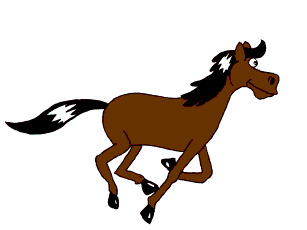
The Burnt City Goat is considered by some to be the "first animation." Briefly Wikipedia had a link to my animated GIF of it (above). I made no opinion on the nerd controversy [1 / 2] over whether the sequence of five images is supposed to be a flipbook image or is just a series of pictures. I said it was an animation because that's what many people said it was and that's what it looks like. If anything I would question whether it is possible for a spinning bowl to produce the blinking "shutter movement" of a Zoetrope or flipbook pages.
So I have no ax to grind in the "historical debate" but I do believe that my animated GIF is the most accurate example out there on Web of what the movement of the images looks like. That has now been banished from Wikipedia because Wikipedian Janke removed the link and pronounced me "not an expert." Yet somehow he has gotten one of his own rather terrible GIFs on the Wikipedia animation page where he removed the link, as example of animation. Check it out:

Here is the back and forth from the Wikipedia discussion page, where Janke rules the roost.
Burnt City Goat
There has been a very interesting discussion on this issue on Niel Cohn site [1]. According to a discussant Britannica considers Pygmalion the first animator, in this Wikipedia article paleolithic cave paintings, the phenakistoscope, and praxinoscope, are presented as the early examples of animation. Moreover, Tom Moody has clearly shown the animation of the bowl in his site [2]. Please discuss your point of view here before reverting the text of the article.
* I am reverting. Stating that it is "considered as the first animation" is one-sided, since there is no evidence that the bowl could have been used to view the goat in motion. The fact that this is contradicted only in a reference makes the statement POV. See all the refs - the most probable use is as a bowl! The moving examples that are shown on the web are creations of today... --Janke | Talk 08:46, 6 May 2009 (UTC)
o Dear Janke Here are a number of arguments, 1. an animation authority such as Tom Moody considers this bawl animation then it is animation; 2. Britannica considers the statue made by pigmentation an early example of animation (despite the fact that that it was not meant to be an animation), 3. The wiki article considers the paleolithic cave paintings as an early example of animation (despite the fact that that it was not meant to be an animation)4. In the Neil Cohn web site the example of Egyptian wall paintings of two wrestler has been cited as an example of early animation ((despite the fact that that it was not meant to be an animation)5.Tom Moody has shown the animation of the images as it could have been seen on a an optical device mentioned in Neil Cohn site. But more importantly this is in the domain of Newton's "Hypotheses non fingo" which implies that while these recorded facts permitted to prove the de facto existence of an animation device through Kepler's laws, one could not establish this de jure. This is the foundation for Kant's distinction between "the question about that which is rightful (quid juris) and that which concerns the fact (quid facti)" (A84 / B 116) Thus, based on the wiki policy of NPOV We can say that: "Some observers have considered this bowl the earliest example of animation". Therefore, I revert the text to its preceding version, and I hope you are reasonable enough to avoid an absurd stand.
I am reverting. A google search shows that Tom Moody is a blogger, not an accepted "animation authority" - if he were, Google would prove it in some way, which it does not. Your references to Newton, Kepler and Kant are totally irrelevant in this case. "Some observers have considered this bowl the earliest example of animation" is technically true, for sure, but this can convey a false impression. Read closely: This article does not state that the cave paintings are "animation". Re. the egyptian mural (which I personally uploaded), note the text (I wrote): "Even though this may appear similar to a series of animation drawings, there was no way of viewing the images in motion." If you wish to revert back, please provide a reference in professional literature that the goat actually was seen in motion 5200 years ago (Such a reference should not be from a local paper or any other possibly biased sources, nor from a blog.) Thank you. (PS: Why do you wish to include a link to the graphical nightmare "thewebofcokaygne"???) --Janke | Talk 05:50, 7 May 2009 (UTC)
The problem with Wikipedia is that non-experts can decide who is an expert and "spin" a subject based on their personal taste. Janke doesn't like the Web of Cokaygne site (which wasn't linked to from Wikipedia, only my blog post) so he substitutes his personal judgment for what's proper for the encyclopedia, with appeals to science and objectivity ("accepted 'animation authority'"). It's hard to beat such a person--likely he watches the site every day, when he's not working on his live steam trains--and will pounce if you change anything he doesn't agree with.
